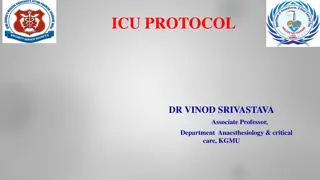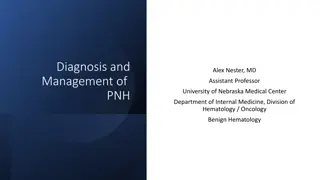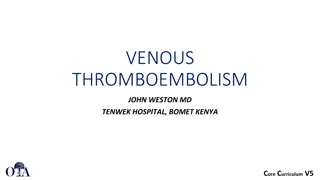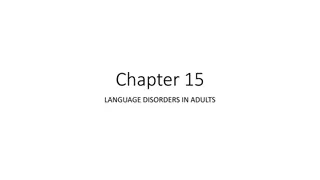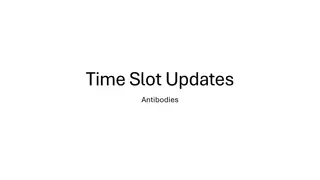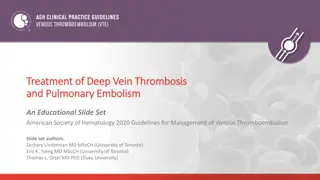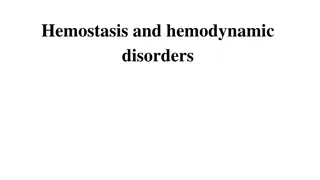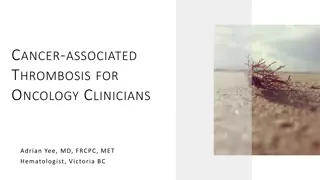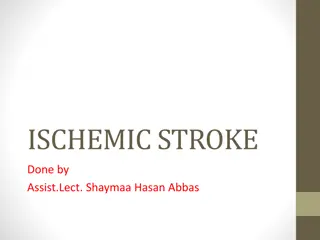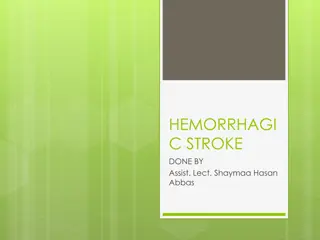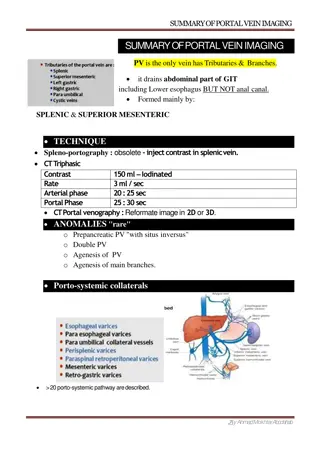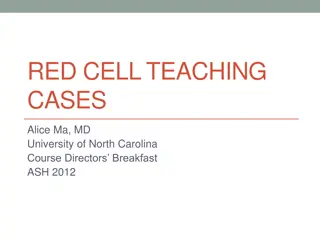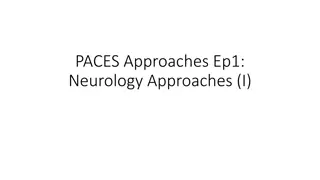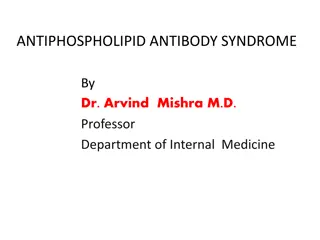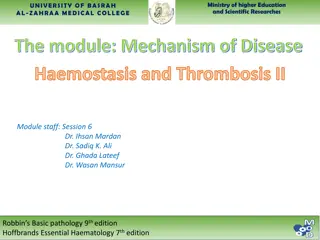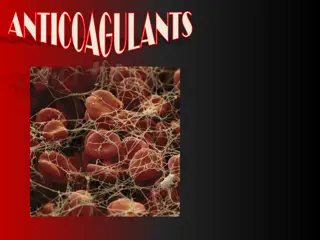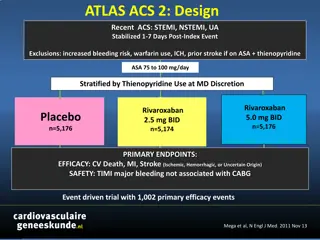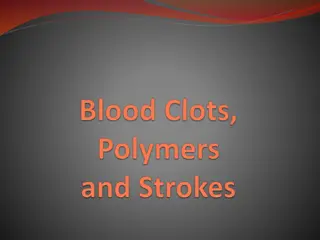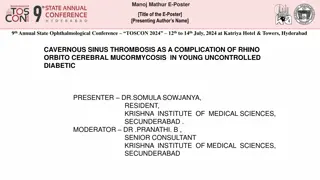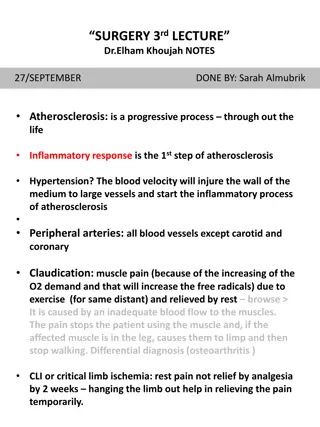Essential Concepts in Haemostasis and Thrombosis
Haemostasis and thrombosis are crucial processes in maintaining vascular integrity and preventing excessive bleeding or clotting. This module explores the mechanisms of haemostasis, including vasoconstriction, platelet plug formation, and coagulation cascade activation, as well as the pathophysiology of thrombosis. Learning objectives cover the balance of coagulant and anticoagulant factors, intrinsic and extrinsic pathways, and the role of platelets in these processes. By understanding these concepts, healthcare professionals can better manage bleeding disorders and thrombotic conditions.
Download Presentation

Please find below an Image/Link to download the presentation.
The content on the website is provided AS IS for your information and personal use only. It may not be sold, licensed, or shared on other websites without obtaining consent from the author.If you encounter any issues during the download, it is possible that the publisher has removed the file from their server.
You are allowed to download the files provided on this website for personal or commercial use, subject to the condition that they are used lawfully. All files are the property of their respective owners.
The content on the website is provided AS IS for your information and personal use only. It may not be sold, licensed, or shared on other websites without obtaining consent from the author.
E N D
Presentation Transcript
UNIVERSITY OF BASRAH AL-ZAHRAA MEDICAL COLLEGE Ministry of higher Education and Scientific Research The module: Mechanism of Disease Session 5 / Lectures 1 Haemostasis and Thrombosis (I) Module staff: Session 5 Dr. Sadiq K. Ali (Module leader) Dr. Ihsan Mardan Dr. Iman Abdul-Hadi Dr. Ghada Lateef Dr. Wasan Mansur Dr. Safa Asaad Robbin s Basic pathology 9th edition Hoffbrands Essential Haematology 7thedition
UNIVERSITY OF BASRAH AL-ZAHRAA MEDICAL COLLEGE Ministry of higher Education and Scientific Research Learning objectives: 1. Haemostasis; Definition Balance of coagulant and anticoagulant factors Intrinsic and extrinsic pathways Role of platelets Fibrinolytic system 2. Thrombosis; Definition Predisposing factors Effects of thrombosis Outcomes
1- HAEMOSTASIS Why don t you bleed to death from a minor injury?
1- HAEMOSTASIS Haemostasis refers more widely to the process whereby blood coagulation is initiated and terminated in a tightly regulated fashion, together with the removal (or fibrinolysis) of the clot as part of vascular remodelling. The normal haemostatic response to vascular damage depends on a closely linked interaction between the blood vessel wall, circulating platelets and blood coagulation factors.
Haemostasis Haemostasis consists of three steps: Vasoconstriction: this is mediated by reflex neurogenic mechanisms. Vasoconstriction reduces flow of blood, thus reducing extent of blood loss. Platelet plug (primary haemostasis): platelets adhere to the subendothelial collagen along with shape change and release of platelet granule contents. Activation of the coagulation cascade (secondary haemostasis): activation of the clotting cascade results in formation of fibrin and cross-linking of fibrin with resultant arrest of bleeding.
The haemostatic mechanisms have several important functions: (1) to maintain blood in a fluid state while it remains circulating within the vascular system; (2) to arrest bleeding at the site of injury or blood loss by formation of a haemostatic plug; (3) to limit this process to the vicinity of the damage and (4) to ensure the eventual removal of the plug whilst healing is completed
HAEMOSTASIS There are at least five different components involved: 1. blood vessels, 2. platelets, 3. plasma coagulation factors and 4. their inhibitors and 5. the fibrinolytic system. Deficiency or exaggeration of any one may lead to either thrombosis or haemorrhage
ENDOTHELIUM Central regulators of haemostasis The balance between the antithrombotic and prothrombotic activities of endothelium determines whether thrombus formation, dissolution occurs. propagation, or At baseline, endothelial cells exhibit antithrombotic (antiplatelet, anticoagulant, and fibrinolytic properties), however, they are capable (after injury or activation) of exhibiting numerous procoagulant activities.
Antithrombotic Properties (Endothelium) Antiplatelet effects An intact endothelium prevents platelets (and plasma coagulation factors) from interacting with the highly thrombogenic subendothelial extracellular matrix (ECM). Prostacyclin (PGI2) and nitric oxide (NO). Adenosine diphosphatase (ADPase). Anticoagulant effects Heparin-like molecules, thrombomodulin and tissue factor pathway inhibitor Fibrinolytic effects Plasminogen activator (t-PA)
Prothrombotic Properties (Endothelium) Platelet effects: Endothelial injury brings platelets into contact with the subendothelial ECM, which includes among its constituents von Willebrand factor (vWF) Procoagulant effects: In response to cytokines (e.g., tumour necrosis factor [TNF] or interleukin-1 [IL-1]) or certain bacterial products endothelial cells produce tissue factor, the major in vivo activator of coagulation, and downregulate the expression of thrombomodulin. including endotoxin, Antifibrinolytic effects: Endothelial cells also secrete inhibitors of plasminogen activator (PAIs)
PLATELETS Platelets play a critical role in normal haemostasis by forming a haemostatic plug that seals vascular defects, and by providing a surface that recruits and concentrates activated coagulation factors. Normal platelet count is 150-400 x 109/L. After vascular injury, platelets encounter ECM constituents (collagen is most important) and adhesive glycoproteins such as vWF.
This sets in motion a series of events that lead to; (1) Platelet adhesion, (2) Platelet activation, and (3) Platelet aggregation. Platelet Adhesion Platelet adhesion initiates clot formation. Adhesion to ECM is mediated largely via interactions with vWF that acting as a bridge between platelet surface receptors (e.g., GpIb) and exposed collagen.
Platelet Activation Secretion of both granule types ( granules and granules) occurs soon after adhesion. The subtle membrane changes include an increase in the surface expression of negatively charged phospholipids, which provide binding sites for both calcium and coagulation factors, and a conformation change in platelet GpIIb/IIIa that permits it to bind fibrinogen.
Platelet Aggregation Aggregation follows platelet adhesion and granule release. In addition to ADP, platelet-synthesized thromboxane A2 which is an important stimulus for platelet aggregation. Aggregation is promoted by bridging interactions between fibrinogen and GpIIb/IIIa receptors on adjacent platelets. ADP and TXA2 promotes formation of an enlarging platelet aggregate, the primary haemostatic plug.
Thrombin binds to a platelet surface receptor (protease-activated receptor, or PAR); in association with ADP and TXA2, this interaction induces further platelet aggregation. Platelet contraction follows, creating an irreversibly fused mass of platelets constituting the definitive secondary haemostatic plug. Concurrently, thrombin converts fibrinogen to fibrin within and about the platelet plug, contributing to the overall stability of the clot.
COAGULATION CACGADE The coagulation cascade is a successive series of amplifying enzymatic reactions. At each step in the process, a proenzyme is proteolyzed to become an active enzyme, which in turn proteolyzes the next proenzyme in the series, eventually leading to the activation of thrombin and the formation of fibrin.
COAGULATION CACGADE These components typically are assembled on a phospholipid surface and are held together by interactions that depend on calcium ions. Once activated, the coagulation cascade must be tightly restricted to the site of injury to prevent inappropriate and potentially dangerous clotting elsewhere in the vascular tree.
In addition to the restriction of factor activation to sites of exposed phospholipids, three categories of natural anticoagulants function to control clotting: 1. antithrombins, 2. proteins C and S, and 3. tissue factor pathway inhibitor (TFPI).
Antithrombins (e.g., antithrombin III) inhibit the activity of thrombin and other serine proteases, factors IXa, Xa, XIa, and XIIa. Proteins C and S are two vitamin K-dependent proteins that inactivate the cofactors Va and VIIIa. Tissue factor pathway inhibitor (TFPI) is a protein secreted by endothelium (and other cell types) that inactivates factor Xa and tissue factor factor VIIa complexes
The coagulation cascade. The traditional concept of blood coagulation with separate intrinsic (red) and extrinsic (blue) pathways converging on the common pathway (green) with the generation of FXa. PT= Prothrombin Time (10-12s) APTT= Activated Partial Thromboplastin Time (26-40s) TT= Thrombin Time (15-19s)
FIBRINOLYTIC SYSTEM Fibrinolysis is largely carried out by plasmin, which breaks down fibrin and interferes with its polymerization The resulting fibrin split products (FSPs or fibrin degradation products). Elevated levels of FSPs (most notably fibrin-derived D-dimers) can be used for diagnosing abnormal thrombotic states including disseminated intravascular coagulation (DIC), deep venous thrombosis, or pulmonary thromboembolism.
Plasmin is generated by proteolysis of plasminogen, an inactive plasma precursor, either by factor XII or by plasminogen activators: Tissue-type plasminogen activator (t-PA) Urokinase-like plasminogen activator (u-PA) Streptokinase
To prevent excess plasmin from lysing thrombi indiscriminately throughout the body, free plasmin rapidly complexes with circulating 2-antiplasmin and is inactivated. Endothelial cells further modulate the coagulation anticoagulation balance by releasing plasminogen activator inhibitors (PAIs) {PAIs increased by inflammatory cytokines that s why thrombosis occurs in severe inflammation}.


